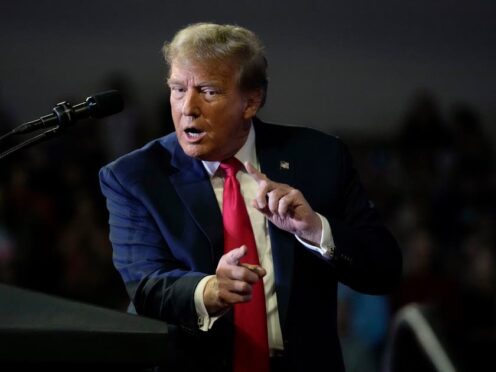
Nato’s leader warned on Sunday that Donald Trump was putting the safety of US troops and their allies at risk after the Republican presidential front-runner said Russia should be able to do “whatever the hell they want” to alliance members who do not meet their defence spending targets.
Mr Trump’s remarks caused deep concern in Poland, a country in central Europe that has been under Russian control more often than not since the end of the 18th century.
Defence Minister Wladyslaw Kosiniak-Kamysz said “no election campaign is an excuse for playing with the security of the alliance”.
Speaking on Saturday at a rally in Conway, South Carolina, Mr Trump recalled how as president he told an unidentified Nato member that he would “encourage” Russia to do as it wishes in cases of Nato allies who are “delinquent”.
“You didn’t pay? You’re delinquent?” Trump recounted saying. “‘No, I would not protect you. In fact, I would encourage them to do whatever the hell they want. You gotta pay. You gotta pay your bills.”
Nato secretary-general Jens Stoltenberg said that the 31 allies are committed to defending each other.
“Nato remains ready and able to defend all allies. Any attack on Nato will be met with a united and forceful response,” Stoltenberg said.
“Any suggestion that allies will not defend each other undermines all of our security, including that of the US, and puts American and European soldiers at increased risk.”
Mr Stoltenberg added in his statement that he expects that “regardless of who wins the presidential election, the US will remain a strong and committed Nato ally.”
The German government did not officially comment on Mr Trump’s remarks, but the country’s foreign office published a statement on Sunday morning pointing out Nato’s principle of solidarity.
“One for all and all for one. This Nato creed keeps more than 950 million people safe – from Anchorage to Erzurum,” the foreign ministry said on X, formerly Twitter.
German daily Frankfurter Allgemeine Zeitung wrote in an editorial that “if Trump will become US president again, such statements will increase the risk of Putin expanding his war.
“Europeans can only do one thing to counter this: finally invest in their military security in line with the seriousness of the situation.”
Mr Trump’s comments were of particular concern to Nato’s front-line countries, like Poland and the Baltic states of Lithuania, Latvia and Estonia, which were either under the control of Moscow or fully incorporated into the Soviet Union during the Cold War.
Fears there run especially high given Russia’s invasion of Ukraine.
While in office, Mr Trump had already threatened not to come to the aid of any country under attack that he considered owed Nato and the US and was not spending enough on defence.
His stance destabilised the alliance, particularly countries with borders close to Russia.
Under Nato’s mutual defence clause, Article 5 of its founding treaty, all allies commit help of any member who comes under attack.
Article 5 has only ever been activated once – by the US in the wake of the September 11 2001 attacks.
After Russia annexed Ukraine’s Crimean Peninsula in 2014, Nato leaders agreed to halt the defence spending cuts made after the end of the Cold War and start moving toward spending 2% of gross domestic product on their military budgets.
No country is in debt to another, or to NATO.
Nato has undertaken its biggest military build-up since the Cold War since Russia invaded Ukraine in February 2022.

Enjoy the convenience of having The Sunday Post delivered as a digital ePaper straight to your smartphone, tablet or computer.
Subscribe for only £5.49 a month and enjoy all the benefits of the printed paper as a digital replica.
Subscribe